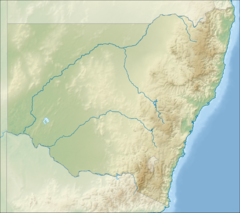Bongil Bongil National Park
| Bongil Bongil National Park | ||
|---|---|---|
|
|
||
| Location: | New South Wales , Australia | |
| Specialty: | Temperate rainforest , wetlands, estuaries | |
| Next city: | Coffs Harbor | |
| Surface: | 42.33 km² | |
| Founding: | March 15, 1995 | |
The Bongil Bongil National Park is a national park in the northeast of the Australian state of New South Wales , 427 km north of Sydney and about 15 km south of Coffs Harbor .
The park has beaches in their natural state, an impressive coastal landscape, wetlands, coastal rainforest and impressive estuaries . Most of the coasts are used as nesting sites for sea birds.
Visitors can hike in the woods and canoe in the estuaries. Many protected bird species can be seen in the park.
Among the endangered birds that can be found in the park include giant stork , little tern , pied oystercatcher , Black Bittern , rose-crowned fruit dove , long-tailed pigeon , ospreys and comb Jacana . Other animals living in the park are koalas , red-necked wallaby , spotted monitor lizard , the long-winged bat Miniopterus australis and the Australian southern frog Mixophyes fasciolatus .
Today's national park was a popular Aboriginal camp in the region until the 1960s. Its name means something like "a place where you stay for a long time because there is plenty of food". It belonged to the settlement area of the Gumbaynggir, who had little to do with Europeans until the plantation of wood plantations in the 1970s. There are numerous traces of Aboriginal people in the park. The park administration works with local Aboriginal communities to preserve the rich cultural heritage.
